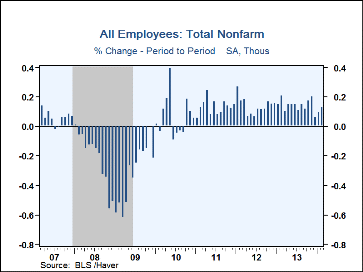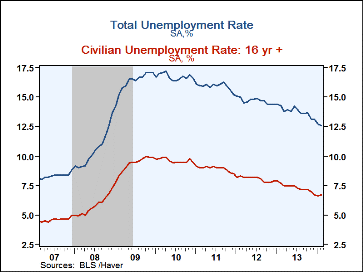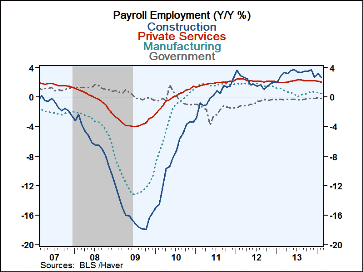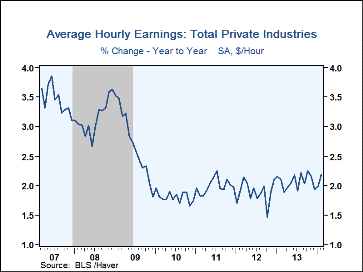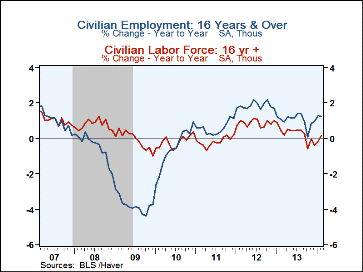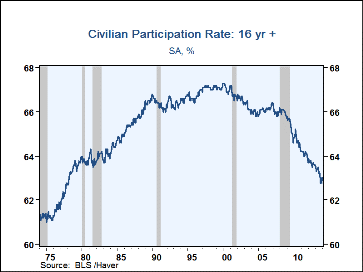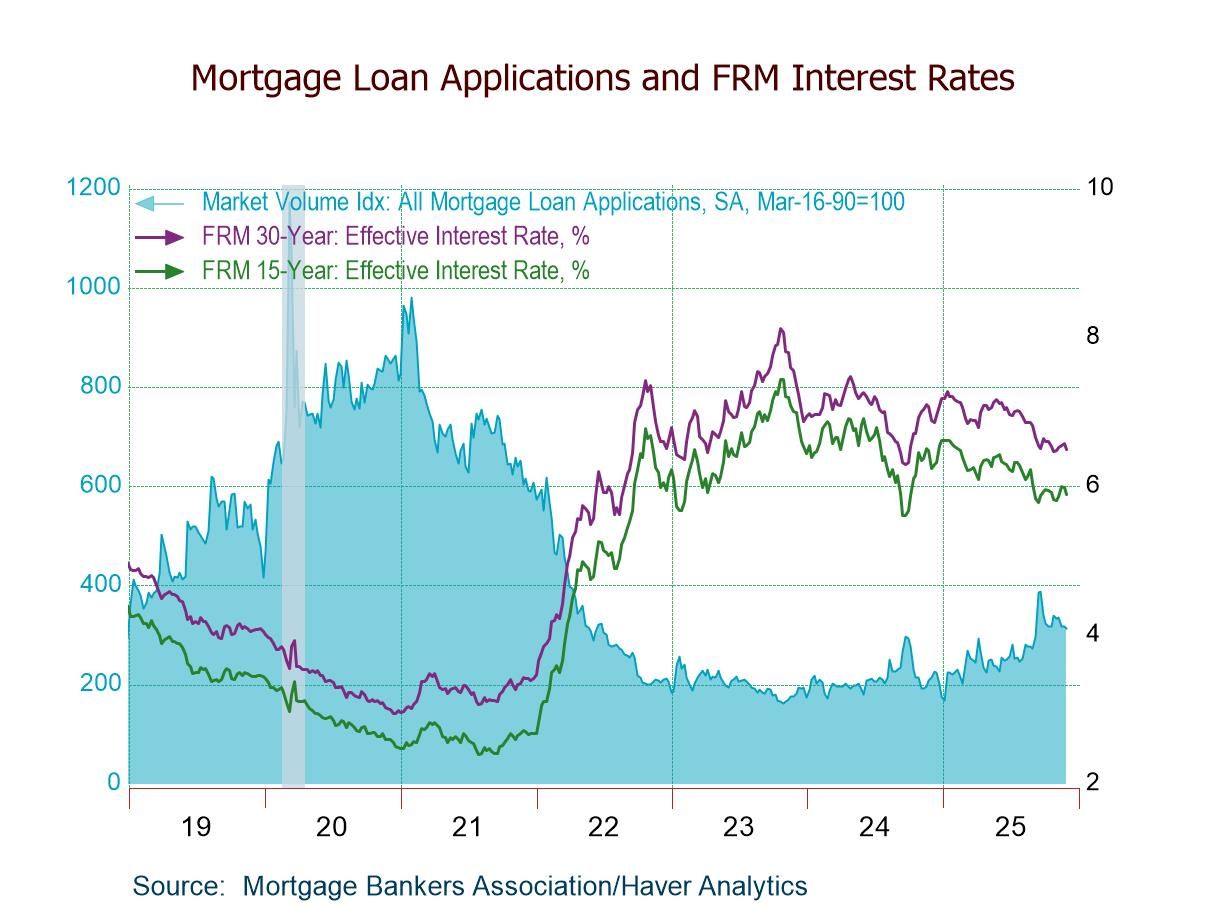 Global| Mar 07 2014
Global| Mar 07 2014U.S. Payroll Employment and Earnings Improve; Jobless Rate Ticks Higher
by:Tom Moeller
|in:Economy in Brief
Summary
Nonfarm payrolls grew 175,000 during February following a 129,000 January increase, initially reported as 113,000. The rise outpaced expectations for a 145,000 increase in the Action Economics Forecast Survey. The unemployment rate [...]
Nonfarm payrolls grew 175,000 during February following a 129,000 January increase, initially reported as 113,000. The rise outpaced expectations for a 145,000 increase in the Action Economics Forecast Survey. The unemployment rate notched up to 6.7% versus expectations for 6.6%. The total jobless rate, including workers who were marginally attached and part-time for economic reasons, declined to 12.6%, the lowest level since November 2008. Average hourly earnings grew 0.4% (2.5% y/y), double expectations and the strongest monthly rise since January 2011.
From the payroll employment survey, the 175,000 increase in jobs was the strongest in three months. Factory sector job growth remained stable at 6,000 (0.5% y/y) but the gain in construction jobs eased to 15,000 (2.6% y/y). In the private service sector, a 140,000 increase (2.0% y/y) in employment also was the firmest since November. The rise was led by a 79,000 increase (3.7% y/y) in professional & business services. Education & health services jobs grew 33,000 (1.6% y/y) while leisure & hospitality employment gained 25,000 (2.9% y/y). Hiring in financial activities jobs improved 9,000 (0.8% y/y) while trade, transportation & utilities employment rose 7,000 (1.9% y/y). To the downside, jobs in information businesses were off 16,000 (-1.6% y/y) and retail trade jobs fell 4,100 (+1.9% y/y). Transportation & warehousing employment was off 3,600 (+2.0% y/y). In the government sector, a 13,000 worker gain (-0.1% y/y) owed to an 11,000 rise (0.5% y/y) in state payrolls and an 8,000 improvement (0.2% y/y) in local hiring. Federal government payrolls fell 6,000 (-3.3% y/y).
During February, a lessened 59.3% of private industries added workers versus January while on average 62.9% added workers since November. The three-month average was 68.6% in December. In the factory sector, a greatly lessened 51.2% of private industries added workers last month. The three-month figure plunged to 54.9%. It was 74.1% in December.
The length of the average workweek declined to 34.2 hours, its shortest since January 2011, from 34.3. Most notable was the drop in construction to 38.0 hours from 39.2 twelve months ago. Private services hours also fell sharply to 33.0 hours versus 33.3 a year ago. The factory workweek was slightly diminished at 40.7 hours versus 40.9 a year earlier. The index of aggregate hours worked (employment times hours) slipped in February and so far in Q1 is down 0.8% (AR) from Q4'13.
Average hourly earnings improved 0.4% (2.5% y/y), the most since June 2013. The gain was led by a 0.7% jump (2.2% y/y) in construction sector earnings then a 0.4% rise (2.1% y/y) in private services pay. Factory sector earnings gained 0.3% (2.4% y/y).
The household employment survey indicated the unemployment rate increased to 6.7%. The rise was the result of a 42,000 (1.3% y/y) increase in employment, outpaced by a 264,000 rise (0.1% y/y) in the labor force. The labor force participation rate, those in the labor force as a percent of the population, improved m/m to 63.0%, but that remained down from 67.1% averaged from 1997 to 2000. The number of individuals not in the labor force rose 2.3% y/y. Growth has been at a similar rate or higher since 2009. The number of workers out of work for 27 weeks or longer fell 18.9% y/y and the number out for 52 weeks or more declined 13.7% y/y. Of those unemployed, 25.4% were out 52 weeks or more.
By educational attainment, those without a high school diploma realized a 9.8% jobless rate while for high school graduates and no college it was 6.4%. Those with some college but no degree had a 6.2% unemployment rate while for college graduates it was 3.4%. By age, individuals over age 25 had a 5.5% jobless rate while those under 25 saw 14.4% unemployment. Teens were 21.4% out of work.
The figures referenced above are available in Haver's USECON database. Additional detail can be found in the LABOR and in the EMPL databases. The expectation figures are from Action Economics and are in the AS1REPNA database.
| Employment: (M/M Chg., 000s) | Feb | Jan | Dec | Y/Y | 2013 | 2012 | 2011 |
|---|---|---|---|---|---|---|---|
| Payroll Employment | 175 | 129 | 84 | 1.6% | 1.7% | 1.7% | 1.2% |
| Previous | -- | 113 | 75 | -- | -- | -- | -- |
| Manufacturing | 6 | 6 | 7 | 0.5 | 0.7 | 1.7 | 1.7 |
| Construction | 15 | 50 | -20 | 2.6 | 3.3 | 2.1 | 0.2 |
| Private Service Producing | 140 | 84 | 99 | 2.0 | 2.2 | 2.2 | 1.9 |
| Government | 13 | -16 | -2 | -0.1 | -0.3 | -0.8 | -1.8 |
| Average Weekly Hours - Private Sector | 34.2 | 34.3 | 34.3 | 34.5 (Feb'13) |
34.5 | 34.4 | 34.3 |
| Average Private Sector Hourly Earnings (%) | 0.4 | 0.2 | 0.1 | 2.2 | 2.1 | 1.9 | 2.0 |
| Unemployment Rate (%) | 6.7 | 6.6 | 6.7 | 7.7 (Feb'13) |
7.4 | 8.1 | 8.9 |
Tom Moeller
AuthorMore in Author Profile »Prior to joining Haver Analytics in 2000, Mr. Moeller worked as the Economist at Chancellor Capital Management from 1985 to 1999. There, he developed comprehensive economic forecasts and interpreted economic data for equity and fixed income portfolio managers. Also at Chancellor, Mr. Moeller worked as an equity analyst and was responsible for researching and rating companies in the economically sensitive automobile and housing industries for investment in Chancellor’s equity portfolio. Prior to joining Chancellor, Mr. Moeller was an Economist at Citibank from 1979 to 1984. He also analyzed pricing behavior in the metals industry for the Council on Wage and Price Stability in Washington, D.C. In 1999, Mr. Moeller received the award for most accurate forecast from the Forecasters' Club of New York. From 1990 to 1992 he was President of the New York Association for Business Economists. Mr. Moeller earned an M.B.A. in Finance from Fordham University, where he graduated in 1987. He holds a Bachelor of Arts in Economics from George Washington University.


